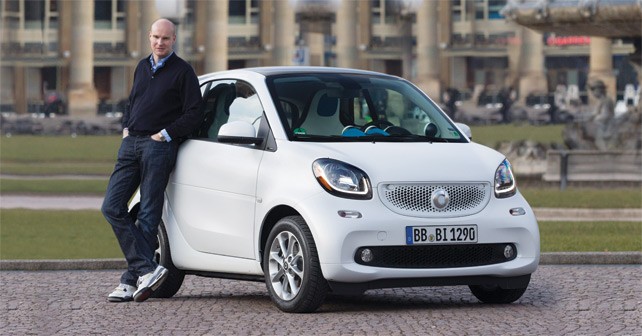
When Daimler’s sub-brand Smart was launched in the late 1990’s, it was an outright attempt to revolutionise the industry. “Reduce to the max” was the catch phrase, and the visionaries claimed that “if we want to continue to live like we’re used to, we have to change.” Conceived by the maker of ‘Swatch’ plastic watches, it started out as a “mobility concept.” Smart tried to reinvent urban mobility with special parking spots for Smart owners – and early car-sharing concepts. It didn’t work. Customers demanded cars, not a “mobility concept.” The brand understood. It grew with the addition of a roadster-coupe and a four-door model. But the move upmarket failed. A compact SUV, the Formore, was killed at a late stage, and Smart reverted to its proven two-seater City Coupe, later to be called the Fortwo. Pity. That SUV would have worked. In the past few years, the brand stagnated. The second-gen model, with its stark and uninspired interior, had grown old. “We desperately need new product,” an executive told us two years ago. And the Fortwo irritated customers with a weak engine, a bouncy suspension, and an automated manual transmission that got the car to shudder with every shift. Now, finally, the third generation of the Smart has arrived – at least in Europe. It’s an interesting car, and perhaps one that could work well in India. While it keeps the basic layout of its predecessor, it has vastly improved in most areas. In fact, from behind the wheel, it would be impossible to tell how small it is. Thanks to the high seating position and the sturdy materials, it feels like a larger car from inside. While retaining its predecessor’s rear-engine concept, the third generation of the Smart is based on an entirely new platform that was co-developed with French carmaker Renault. It’s a lot wider that the previous model, but it’s just as short. You can’t beat it in congested metropolitan areas, where finding a suitable parking spot frequently turns into a nightmare. The styling has evolved strongly, with the one-box look of the original model being replaced by a pronounced ‘one-and-a-half-box’ appearance. Suddenly, it has grown up. Instead of the previous model’s somewhat clueless smile, the Smart now looks determined and slightly mischievous. Down the road, Smart will launch a convertible, a fully electric version, and a top-of-the-line model tweaked by tuner Brabus to make around 110 horsepower. But even the current engine line-up is satisfactory – especially the 90-horsepower, 0.9-litre turbo which I drove a few weeks ago. The sprint from zero to 100km/h now takes just over ten seconds, and the Smart is governed at 155km/h. The power boost truly transforms the driving experience. It can move through traffic with alacrity, and passing manoeuvres can be handled with ease. The dreadful single-clutch automated manual is gone – drivers now get the choice of a five-speed manual box, or a Getrag-supplied six-speed dual-clutch automatic. The wider track means a lot more stability, and there is a modicum of comfort to handle even longer trips. The steering has become more direct, and the biggest surprise is the ultra-small turning circle. The Smart can almost turn on the spot. The aforementioned penalties – weak power, and a lack of comfort – are a thing of the past. Smart doesn’t require compromise anymore. Inside, the Smart is made for people who prefer authenticity over conventional notions of luxury. Authenticity, here, means that Smart doesn’t even try to hide the fact that it is largely made of plastic. The ovoid shapes and funky colour combinations resemble a modern lounge or a club. There is no visual connection to other vehicles made by Daimler. With a cutting-edge infotainment system and apps that connect the car with your iPhone or Android, Smart is ahead of other vehicles in its price range – and way beyond. Smart is still unlike any other car on the market. Its tiny size means that you won’t be able to take more than one passenger along. But it is so easy to manoeuvre around the city that any bigger car will feel clumsy. Finding a parking spot is never a problem. And because the Smart isn’t cheap, it’s a pretty convincing luxury and fashion statement – and probably a perfect second or third car. It works in Berlin and New York – so why not in Delhi and Mumbai?























Write your Comment